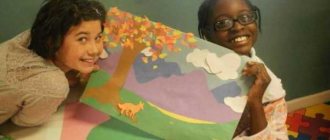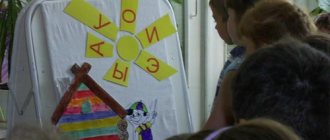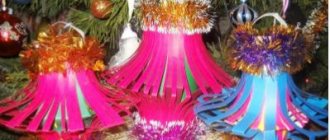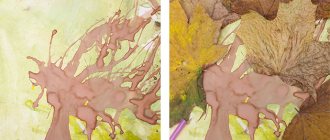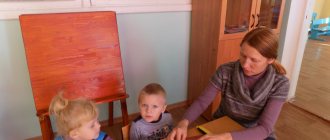Thematic week on the topic “Let's help birds survive the winter” in the preparatory group.
find? Goal: to summarize children’s knowledge about wintering birds ,
their needs; evoke in children sympathy and a desire to help them.
4.Getting to know the model «
Bird
"
.
Purpose: to clarify children’s understanding of the structure of birds .
Learn to use the iconic-symbolic diagram of the structure of birds
.
5.D/I “I’ll start, and you continue.” Goal: to exercise the ability to describe a bird according to certain characteristics, to consolidate the names of birds .
Walk
1. Situational conversation “What do birds eat?” invite children to watch the feeders, what birds fly in?, who has what habits?, what birds like what kind of food? Cultivate observation skills
2.P/I “The Kite and the Hen”. Exercise children in performing the “side gallop” step.
3. Outdoor game “Fourth odd”. Goal: develop the ability to classify birds ,
responding to the teacher’s mistake with certain movements.
4.Work assignment: Offer to pour bird food.
Goal: to cultivate a desire to help birds in winter
.
Evening
1. Conversation about migratory birds. Goal: to form a generalized idea of migratory birds ,
learn to distinguish them according to an essential feature: the ability to satisfy the need for food;
consolidate knowledge about the importance of birds in people's lives .
Enrich your vocabulary on the topic “Migratory birds
”.
2. Reading fiction: V. Bianki “Red Hill” (from the collection “Forest Were” - continuation).
3.D/I “Build a bird.” Goal: to practice the ability to build an image of a bird using geometric shapes.
4.D/I “Whose tail? Whose beak? Goal: to practice the ability to name birds based on external features.
5. Outdoor game “Wolf in the Moat”. Goal: continue to teach how to follow the rules of the game, act (imitate the movements of a wolf and geese) according to the chosen role and text.
THURSDAY
Morning.
1.Conversation
with children “Hello, winter-winter
.”
Purpose: to give an idea of winter phenomena that affect the life and behavior of birds
.
2. Didactic game “Who can name the most migratory birds .”
Goal: consolidate knowledge about migratory birds
.
3. Exercise for fingers to the text of I. Tokmakova’s poem “A Flock of Birds.” Goal: develop fine motor skills, memorize the text of the poem.
Walk
1. Observation of tits. They flew out of the forest in search of food. Write a comparative story about a tit. Consider their color. Tell them that they got their name because of their singing: “Xin - Xin.”
2. D/I “How many birds are there on the feeder?” Goal: to teach how to compose and solve simple problems on a visual basis.
3. Situational conversation “Do birds bring benefit or harm?”
Evening
1.D/I “Counting sticks”. Purpose: to practice the ability to make birds from counting sticks .
D/I "The Fourth Wheel". Goal: to develop children's attention and observation skills.
Conversation for older children on the topic: Birds
CONVERSATION for children 5-7 years old
On the stand there are pictures with birds divided into three groups.
The children come up, look at the pictures, and don’t understand why they are divided into groups. The teacher explains that these birds were divided into three groups: the first group is wintering (sparrow, crow, magpie, jackdaw, tit, woodpecker, jay, nuthatch). They do not fly to warm countries in the fall, as they have adapted to the harsh season and can find food for themselves even in winter. It is very difficult for birds to feed themselves; there is not enough food in winter, and their appetite is enormous. Therefore, many birds, having found food, inform the others by shouting to them. Helping each other, they survive until spring. Some birds (tit, jay, nuthatch) stock up in the fall. For example, acorns and nuts are hidden in the cracks of the trunks. - Guys, who knows which bird gives birth to chicks in winter? - Do you want to know? Guys, crossbills have chicks in winter. This bird not only winters with us, but also breeds chicks. These birds feed on the seeds of coniferous trees and their chicks also feed them. And in the second group, migratory birds (bullfinches, waxwings, goldfinches) are called that because they appear here only on passage. In the summer, these birds live only in the northern forests, where they hatch their chicks, and in the fall, as soon as frost sets in, they fly to us, feed on the berries of rowan, hawthorn, rose hips, and sea buckthorn and fly further south. The third group of birds are migratory. When autumn comes, birds gather in flocks and prepare to fly south. These birds feed on insects. In the fall, insects hide. Food becomes scarce, and the birds fly away to warmer climes. — Guys, what migratory birds do you know? - Right. (Rooks, starlings, swallows, finches, nightingales, larks, cuckoos, cranes, swans, geese). Small birds fly in unnoticed, but large birds scream loudly. This is the leader giving a signal: don’t lag behind, fly after me. Males always arrive earlier to prepare a home for the future family. As soon as the home is ready, the eggs will appear there. The chicks will warm them with their warmth and helpless fledgling chicks will hatch from them. The voracious chicks have bright yellow or red mouths that open wide, and caring parents feed them midges, mosquitoes or caterpillars. From early morning until the evening, birds search for food for their babies, while destroying harmful insects, saving forests and crops in fields, squares and gardens. The chicks grow quickly, and soon adult birds will teach them to look for food, escape from enemies, choose a place to spend the night, recognize and give various signals - messages. If you come to the forest for a walk, try not to run, don’t make noise, don’t look into birds’ nests, and don’t touch eggs and chicks with your hands. You can scare the birds, they will abandon their home and the chicks will die, or the chicks will not hatch from the eggs. Poem We arrived at the unfinished dacha in the spring. I woke up at dawn, I see the sky above me. The roof in the kitchen is not covered. We have a hole in the ceiling. We set up a trough, a copper basin and two buckets. You wake up in a thunderstorm - The rain gurgles in the basin, Lightning flashes through the crack - Thunder rumbles above you... And yesterday a bird flew through the roof straight into the house. I searched everywhere, I see chicks in the nest. There are five chicks on the litter, Five fluffy twins. Children have such mouths - You can hear a squeak half a mile away. If the mother doesn’t arrive, the Squeak gets louder and louder! I don’t know what to do, at least fly after her! Suddenly I hear from my grandmother that the stove maker will build the stove for us, and then he will fix the roof, and it will not leak. What will happen to the nest? How will the bird return to the house? I stand and almost cry - The stove maker is coming to our dacha, He shouts from afar: - Have you been looking for the stove maker? “No,” I shout back to him, “the neighbor was looking for the stove maker!” There's smoke coming out of the stove and the chimney hasn't been cleaned. I was afraid that he would return, I walked with him to the well, took him to the corner, took him away from our dacha. A bird flies over its nest and flies straight into the house. The rain is pouring from the ceiling, But the chicks are still growing. — Guys, what new did you learn from our conversation? 1. What three groups can birds be divided into? 2. What wintering birds do you know? 3. Why are bullfinches and waxwings called migratory birds? 4. What migratory birds do you know? 5. Why do migratory birds fly south in the fall? 6. When do migratory birds return to our region? Why? 7. Why can’t you make noise in the forest? 8. Why are birds called friends of the forest and people? - Yes, the bird guys are our friends! They not only decorate nature, but also help preserve crops in fields and gardens, save forests from pests, and spread plant seeds. And you need to take care of your friends! Help the birds survive the winter by setting up feeders for them. After all, a hungry bird can die from a slight frost, but a well-fed bird is not afraid of cold!
We recommend watching:
Summary of a thematic conversation in the senior group on the topic: Friendship A fairy tale for children 4-6 years old about birds Lapbook for children of the middle and senior groups. Birds Entertainment Script. Bird Day in the preparatory group
Similar articles:
Bird Day in kindergarten. Senior group. Scenario
Summary of the lesson “Birds in spring”. Senior group
Conversation about courage with older preschoolers
Conversation about hard work in the preparatory group
Conversation about envy with preschoolers of the preparatory group
